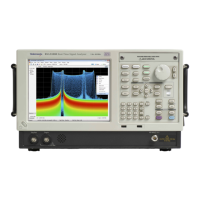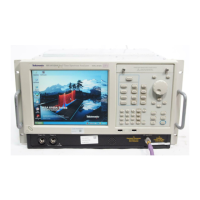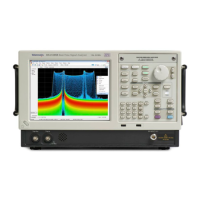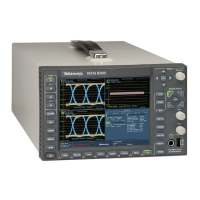Performance ver
ification
12. S et the signal generator amplitude for –5 dBm at the power meter and RSA306B.
13. Repeat steps 5 through 8 to measure and record for all the frequencies in the channel flatness table, 1260 MHz through
1300 MHz. (See
Table 11.) Do not change the RSA306B center frequency setting.
14. Change the RSA
306B center frequency to 2160 MHz. Keep other settings the same.
15. S et the signal
generator frequency to 2140 MHz.
16. S et the signa
l generator amplitude for –5 dBm at the power meter and RS A306B.
17. Repeat steps
5 through 8 to measure and record for all the frequencies in the channel flatness table, 2140 MHz through
2180 MHz. (See Table 12.) Do not change the RSA306B center frequency setting. An alternate IF setting is used in
this range. This verifies the alternate s etting.
18. Use the recorded values to calculate the amplitude differences for each measured frequency in the three channel
flatness tab
les.
Differenc
e amplitude = (power meter amplitude – RSA306B marker amplitude)
The measur
ed amplitudes are dBm. The difference amplitude is dB.
19. Calculate
the channel flatness error relative the center screen amplitude. Center screen value:
22 MHz for
the 2 – 42 MHz channel
1280 MHz f
or the 1260 – 1300 MHz channel
2160 MHz f
or the 2140 – 2180 MHz channel
The flatn
ess error at each frequency is:
Error = (
difference amplitude, each frequency – difference amplitude, center screen frequency)
NOTE. All a mplitudes are in dB.
At center screen, Error = 0 dB.
Example calculation for 2 MHz frequency, 22 MHz center screen:
22 MHz Center screen difference amplitude = +0.13 dB
2 MHz Frequency difference amplitude = –0.32 dB
Error = (–0.32 dB – (0.13 dB)) = –0.45 dB
RSA306B Specifications and Performance Verification 27
